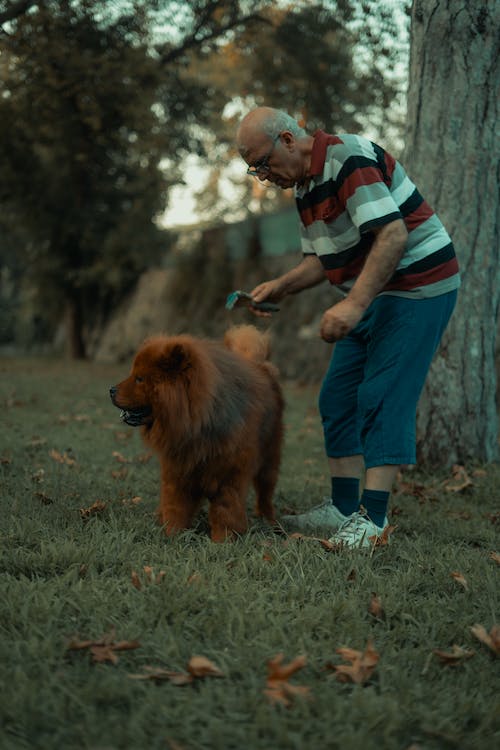Despite being an ancient behemoth, the Tibetan Mastiff is a big softie that is gentle and mellow around the house and only fierce when it comes to loving his family. He retains his guardian nature, independent, intelligent, and devoted to protecting his home and beloved humans, and tends to be aloof and territorial to strangers. More lion-like in appearance, he is surprisingly graceful and light-footed, and as swift in warming peoples’ hearts with his regal, insightful expression.
Origins of the Tibetan Mastiff
Being one of the oldest breeds in the world and having lived in isolation in the Tibetan Plateau, the history of Tibetan Mastiffs’ existence and progenitors have been lost. What’s known is that he is the mighty guardian breed of Himalayas that either served as protectors of monasteries and villages or accompanied nomadic herdsmen and watched over their flocks.
Documents show that the Tibetan Mastiff is the ancestor of all modern mastiffs. Travelers to Tibet are said to have received these gargantuan creatures as gifts. Through that, they began appearing in other parts of the world and were used for the development of the mastiff breeds from the Middle East and Europe.
Tibetan Mastiffs first reached the United States in the 1970s and was recognized by the American Kennel Club in 2006, becoming AKC’s 155th breed.
Characteristics of the Tibetan Mastiff
Height: 24-26 inches
Weight: 70-150 pounds
Life Expectancy: 10-12 years
Hypoallergenic: No
Massive, heavy, but athletic, the Tibetan Mastiff blends power and agility. His body is relatively longer than it is tall, with a slow and steady walk but a nimble and vigorous trot. Though he has a formidable impressive appearance, he possesses a rather earnest and tender expression. His coat is thick, coarse, stiff, relatively long, and standing off from his body. Meanwhile, his neck, shoulder, tail, and hind legs are densely coated. Sporting a little undercoat during warm weather and a heavier one during the colder seasons helped the Tibetan Mastiff withstand the extreme weather in the Himalayan.
This breed should be defined solely by its size. Being used to guard people for hundreds of years, he is unexpectedly swift, always ready to stand in the way, and protect his family. He loves his people intensely. While he may not be vulgar with his affection, what he loves the most is to spend time with his family and protect them.
Reserved and vigilant, his attitude may change towards strangers or visitors, though. He will not let anyone enter the home until he gets his owners’ go-signal. However, getting permission doesn’t mean he will let down his guard, as he will always be hesitant and suspicious when it comes to unfamiliar people coming near to his beloved humans.
With that, the Tibetan Mastiff can be stubborn and strong-willed. He is independent and intelligent, often devising his own agenda. Fortunately, he learns quickly. However, he would not deter making his own decisions or breaking the rules if he thinks it’s for their family’s safety.
The Tibetan Mastiff is somewhat sensitive. If he sees someone arguing in the family, he will not hesitate to mediate. Though he wants to please his people, he always stays true to its roots and takes his job seriously as the devoted family guardian.
Caring for the Tibetan Mastiff
While the Tibetan Mastiff has very thick fur, it is a low-maintenance coat that only requires minimal grooming most of the year. Weekly brushing using a long pin or slicker brush is usually enough to eliminate dirt and debris. Meanwhile, a wide-tooth comb is handy in removing tangles and mats on the mane, breeches, and tail.
He is known for shedding his undercoat once a year, and massive shedding occurs from late spring to summer. As such, more brushing is needed during the said months. Having a de-shedding tool or undercoat rake will make the job easier. As he tends to have little odor, bathing would be needed but not more than once each month.
Other grooming upkeep includes nail care, dental hygiene, and ear cleaning. Trim his nails at least once a month or as necessary. Having short nails protects his feet as it avoids getting caught on surfaces, especially if the home is carpeted. Then, brush his teeth occasionally using vet-approved toothpaste and dog toothbrush to remove bacteria and tartar build-up. To complete his grooming routine, check his ear and clean as necessary to avoid any infection.
As big dogs, the Tibetan Mastiffs need at least an hour of exercise each day to keep him healthy. He’ll appreciate walks, accompanied by play sessions and puzzle games. However, keep in mind that he has a very thick coat. Make sure to bring him outside during the early morning or evenings during the summer months to avoid the hottest times of the day.
In terms of training, teaching the Tibetan Mastiff can be quite challenging, given that he can be willful and independent. He has a strong sense of himself, which is why you need to establish your role as the leader he can look up to. While he needs consistency and firmness, he knows his value and will not accept harsh words, punishment, or force. Using positive reinforcement and rewards instead makes them more amenable to training.
A large breed, you probably already know that the Tibetan Mastiff needs a good amount of food, requiring two to four cups daily, depending on his age and size. Feeding him high-quality, complete, and balanced dog food to keep him healthy.
The Tibetan Mastiff is generally a hardy breed, facing only a few concerns present with other dog breeds, such as hip and elbow dysplasia, hypothyroidism, and eye disorders like ectropion and entropion. There are recorded cases of seizures, though they are not common and are not prevalent in the breed. Bring him to your trusted veterinarian regularly to detect or prevent any health condition and ensure that your Tibetan Mastiff gets a long, healthy life.

